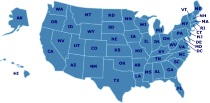Native Americans
Things to See & Do in New Jersey
Maurice National Wild & Scenic River
The Maurice River and its tributaries drain the southwest portion of the Pinelands National Reserve, providing a critical link between the Reserve and the Delaware Estuary. The Pinelands Commission considers the entire Manumuskin watershed an ecologically critical area, with the vast, unspoiled Kirkwood-Cohansey aquifer underlying most of the region. State and local governments, and conservation organizations own significant acreage for preservation purposes. The rivers and associated wetlands serve as nurseries for ocean-going wildlife, offering food and habitat for resident and migrating species, many of which are considered endangered. Each year, huge flocks of birds alight within the watershed to enjoy the area's natural bounty. The Maurice River corridor is rich in natural, cultural and historical significance. Its tributaries, and the bay beyond, not only shaped the lifestyle and livelihood of the region's past inhabitants, but they continue to support the areas' economy and the lifestyle of many residents today. Early industries relied on the river water channeled swiftly into flowing mill races. Some residents built dikes so they could farm the often boggy land close to the river. Others worked in maritime occupations. Local ship builders provided vessels for fishing and for carrying local products to distant markets. The region's entire glass making industry emerged because of, and still depends on the sandy deposits found throughout the watershed. Cumberland County's heritage is steeped in the history of the Lenni-Lenape people, a nation that numbers some 6,000 inhabitants at the time of the earliest colonial explorations of the Delaware Bay region.
Lower Delaware National Wild & Scenic River
The lower Delaware River region contains immense resource diversity, combining an area of high population density with a wealth of natural, cultural, and historical resources and recreational opportunities. The river valley houses cliffs rising 400 feet above the rivers that provide for magnificent scenery and habitat unique to the region. The south-facing, desert-like slopes are home to the prickly pear cactus, while the north-facing slopes display flora and fauna usually only found in arctic-apline climates. The river itself provides habitat for American shad, striped bass, and river herring and is an important component of the Atlantic Flyway, one of four major waterfowl routes in North America. From a historic veiwpoint, the river is one of the most significant corridors in the nation, containing buildings used during Washington's famous crossing, historic navigation channels, Native American and colonial archeological sites, and 19th century mills.
Featured Resources
As an Amazon Associate, we earn from qualifying purchases. We get commissions for purchases made through links on this site.
The Story of the World
This book series by Susan Wise Bauer is another that is best enjoyed as a read aloud rather than seen as a history textbook. It is full of engaging stories, mixing facts and historical legends. The companion study guides offer questions, narration exercises, activities, crafts, and reproducible pages. There are also lists for each chapter of supplemental books that are easily found at your local library.
Story of the World: History for the Classical Child, Volume 1: Ancient Times (From the Ear...
America's Spectacular National Parks
The concept of the national park is an American contribution to world civilization, and it remains a defining characteristic of our country. From the rocky shore of Maine's Acadia to the barren crater and lush rain forest of Hawaii's Haleakala, America's national beauty is celebrated and preserved in its national parks. This book retells the history of each park, describes its most important features and wildlife, and reproduces its gorgeous scenery in full-color photographs that will enthrall a...
100+ New Jersey Drivers Licensing Exam Facts That You Need To Know: Quick Review for the Written Test
Prepare for the New Jersey's Driver's Written Exam. Know the 100+ important facts for the test. Be prepared to ace the exam!
Learning Language Arts Through Literature
Learning Language Arts Through Literature is a fully integrated language arts program that teaches grammar, reading, spelling, vocabulary, writing mechanics, creative writing, thinking skills and more.
Pass Your New York DMV Test Guaranteed! 50 Real Test Questions! New York DMV Practice Test Questions
This book is written by a former DMV classroom instructor. He shares the 50 most common questions and answers to the New York DMV written test. A great guide to help your teen pass the DMV test on their first try.



